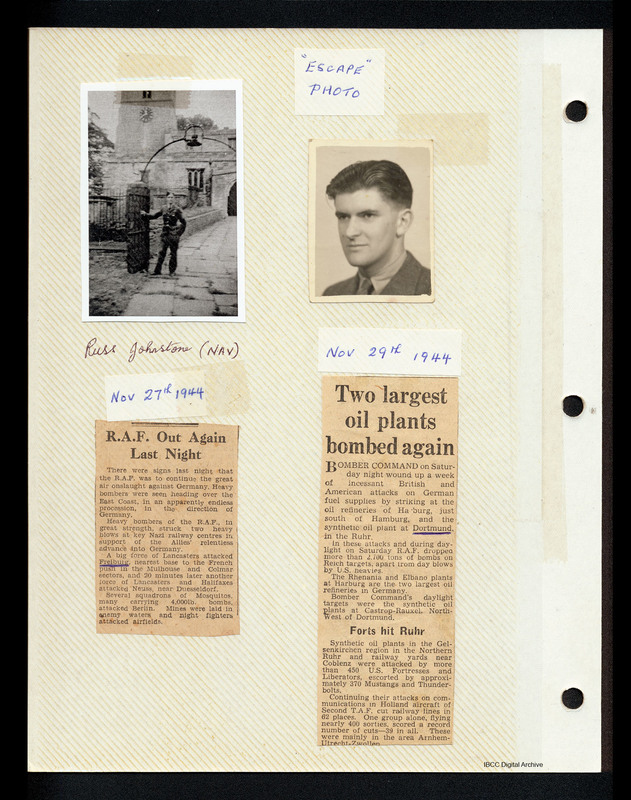Escape Photo
Title
Escape Photo
Russ Johnstone and Syd Marshall
Description
Photograph 1 is of Russ Johnstone in airman's uniform standing by a gate outside a church, it is captioned 'Russ Johnstone (Nav)'. Photograph 2 is a head and shoulders photograph of Syd Marshall. Cutting 1 describes a large operation heading to Freiburg, Neuss and Berlin. Captioned 'Nov 27th 1944'. Cutting 2 describes large attacks on Harburg and Castrop-Rauxel oil refineries by the RAF. Gelsenkirchen was bombed by the United Stated Army Air Force and the Second Tactical Air Force cut railway lines in Holland. Captioned 'Nov 29th 1944'.
Date
1944-11-27
1944-11-29
Language
Format
Two b/w photographs and two newspaper cuttings from an album page
Publisher
Rights
This content is available under a CC BY-NC 4.0 International license (Creative Commons Attribution-NonCommercial 4.0). It has been published ‘as is’ and may contain inaccuracies or culturally inappropriate references that do not necessarily reflect the official policy or position of the University of Lincoln or the International Bomber Command Centre. For more information, visit https://creativecommons.org/licenses/by-nc/4.0/ and https://ibccdigitalarchive.lincoln.ac.uk/omeka/legal.
Contributor
Identifier
SMarshallS1594781v10017
Transcription
[photograph]
Russ Johnstone (NAV)
Nov 27th 1944
R.A.F. Out Again Last Night
There were signs last night that the R.A.F. was to continue the great air onslaught against Germany. Heavy bombers were seen heading over the East Coast, in the direction of Germany.
Heavy bombers of the R.A.F., in great strength, struck two heavy blows at key Nazi railway centres in support of the Allies’ relentless advance into Germany.
A big force of Lancasters attacked [underlined]Freiburg[/underlined], nearest base to the French push in the Mulhouse and Colmar sectors, and 20 minutes later another force of Lancasters and Halifaxes attacked Neuss, near Duesseldorf.
Several squadrons of Mosquitos, many carrying 4,000lb. bombs, attacked Berlin. Mines were laid in enemy waters and night fighters attacked airfields.
"ESCAPE" PHOTO
[photograph]
Nov 29th 1944
Two largest oil plants bombed again
BOMBER COMMAND on Saturday night wound up a week of incessant British and American attacks on German fuel supplies by striking at the oil refineries of Harburg, just south of Hamburg, and the synthetic oil plant at [underlined]Dortmund[/underlined], in the Ruhr.
In these attacks and during daylight on Saturday R.A.F. dropped more than 2,700 tons of bombs on Reich targets, apart from day blows by U.S. heavies.
The Rhenania and Elbano plants at Harburg are the two largest oil refineries in Germany.
Bomber Command’s daylight targets were the synthetic oil plants at Castrop-Rauxel, North-West of Dortmund.
Forts hit Ruhr
Synthetic oil plants in the Gelsenkirchen region in the Northern Ruhr and railway yards near Coblenz were attacked by more than 450 U.S. Fortresses and Liberators, escorted by approximately 370 Mustangs and Thunderbolts.
Continuing their attacks on communications in Holland aircraft of Second T.A.F. cut railway lines in 62 places. One group alone, flying 400 sorties, scored a record of cuts – 39 in all. These were mainly in the area Arnhem-Utrecht-Zwolle.
Russ Johnstone (NAV)
Nov 27th 1944
R.A.F. Out Again Last Night
There were signs last night that the R.A.F. was to continue the great air onslaught against Germany. Heavy bombers were seen heading over the East Coast, in the direction of Germany.
Heavy bombers of the R.A.F., in great strength, struck two heavy blows at key Nazi railway centres in support of the Allies’ relentless advance into Germany.
A big force of Lancasters attacked [underlined]Freiburg[/underlined], nearest base to the French push in the Mulhouse and Colmar sectors, and 20 minutes later another force of Lancasters and Halifaxes attacked Neuss, near Duesseldorf.
Several squadrons of Mosquitos, many carrying 4,000lb. bombs, attacked Berlin. Mines were laid in enemy waters and night fighters attacked airfields.
"ESCAPE" PHOTO
[photograph]
Nov 29th 1944
Two largest oil plants bombed again
BOMBER COMMAND on Saturday night wound up a week of incessant British and American attacks on German fuel supplies by striking at the oil refineries of Harburg, just south of Hamburg, and the synthetic oil plant at [underlined]Dortmund[/underlined], in the Ruhr.
In these attacks and during daylight on Saturday R.A.F. dropped more than 2,700 tons of bombs on Reich targets, apart from day blows by U.S. heavies.
The Rhenania and Elbano plants at Harburg are the two largest oil refineries in Germany.
Bomber Command’s daylight targets were the synthetic oil plants at Castrop-Rauxel, North-West of Dortmund.
Forts hit Ruhr
Synthetic oil plants in the Gelsenkirchen region in the Northern Ruhr and railway yards near Coblenz were attacked by more than 450 U.S. Fortresses and Liberators, escorted by approximately 370 Mustangs and Thunderbolts.
Continuing their attacks on communications in Holland aircraft of Second T.A.F. cut railway lines in 62 places. One group alone, flying 400 sorties, scored a record of cuts – 39 in all. These were mainly in the area Arnhem-Utrecht-Zwolle.
Collection
Citation
“Escape Photo,” IBCC Digital Archive, accessed October 30, 2024, https://ibccdigitalarchive.lincoln.ac.uk/omeka/collections/document/2454.
Item Relations
This item has no relations.

